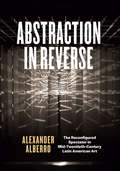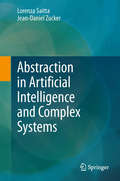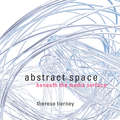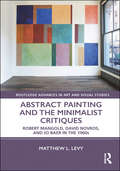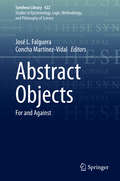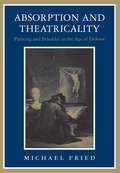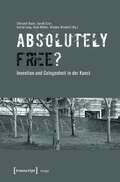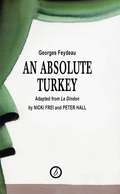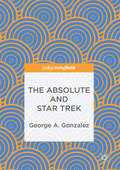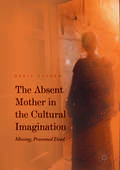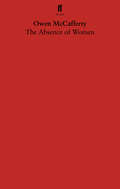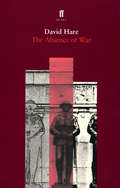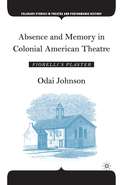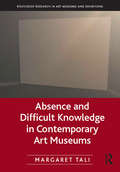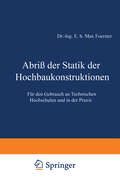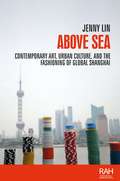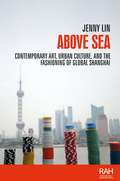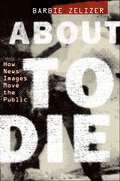- Table View
- List View
Abstraction in Reverse: The Reconfigured Spectator in Mid-Twentieth-Century Latin American Art
by Alexander AlberroDuring the mid-twentieth century, Latin American artists working in several different cities radically altered the nature of modern art. Reimagining the relationship of art to its public, these artists granted the spectator an unprecedented role in the realization of the artwork. The first book to explore this phenomenon on an international scale, Abstraction in Reverse traces the movement as it evolved across South America and parts of Europe. Alexander Alberro demonstrates that artists such as Tomás Maldonado, Jesús Soto, Julio Le Parc, and Lygia Clark, in breaking with the core tenets of the form of abstract art known as Concrete art, redefined the role of both the artist and the spectator. Instead of manufacturing autonomous art, these artists produced artworks that required the presence of the spectator to be complete. Alberro also shows the various ways these artists strategically demoted regionalism in favor of a new modernist voice that transcended the traditions of the nation-state and contributed to a nascent globalization of the art world.
Abstraction in Reverse: The Reconfigured Spectator in Mid-Twentieth-Century Latin American Art
by Alexander AlberroDuring the mid-twentieth century, Latin American artists working in several different cities radically altered the nature of modern art. Reimagining the relationship of art to its public, these artists granted the spectator an unprecedented role in the realization of the artwork. The first book to explore this phenomenon on an international scale, Abstraction in Reverse traces the movement as it evolved across South America and parts of Europe. Alexander Alberro demonstrates that artists such as Tomás Maldonado, Jesús Soto, Julio Le Parc, and Lygia Clark, in breaking with the core tenets of the form of abstract art known as Concrete art, redefined the role of both the artist and the spectator. Instead of manufacturing autonomous art, these artists produced artworks that required the presence of the spectator to be complete. Alberro also shows the various ways these artists strategically demoted regionalism in favor of a new modernist voice that transcended the traditions of the nation-state and contributed to a nascent globalization of the art world.
Abstraction in Reverse: The Reconfigured Spectator in Mid-Twentieth-Century Latin American Art
by Alexander AlberroDuring the mid-twentieth century, Latin American artists working in several different cities radically altered the nature of modern art. Reimagining the relationship of art to its public, these artists granted the spectator an unprecedented role in the realization of the artwork. The first book to explore this phenomenon on an international scale, Abstraction in Reverse traces the movement as it evolved across South America and parts of Europe. Alexander Alberro demonstrates that artists such as Tomás Maldonado, Jesús Soto, Julio Le Parc, and Lygia Clark, in breaking with the core tenets of the form of abstract art known as Concrete art, redefined the role of both the artist and the spectator. Instead of manufacturing autonomous art, these artists produced artworks that required the presence of the spectator to be complete. Alberro also shows the various ways these artists strategically demoted regionalism in favor of a new modernist voice that transcended the traditions of the nation-state and contributed to a nascent globalization of the art world.
Abstraction in Artificial Intelligence and Complex Systems
by Lorenza Saitta Jean-Daniel ZuckerAbstraction is a fundamental mechanism underlying both human and artificial perception, representation of knowledge, reasoning and learning. This mechanism plays a crucial role in many disciplines, notably Computer Programming, Natural and Artificial Vision, Complex Systems, Artificial Intelligence and Machine Learning, Art, and Cognitive Sciences. This book first provides the reader with an overview of the notions of abstraction proposed in various disciplines by comparing both commonalities and differences. After discussing the characterizing properties of abstraction, a formal model, the KRA model, is presented to capture them. This model makes the notion of abstraction easily applicable by means of the introduction of a set of abstraction operators and abstraction patterns, reusable across different domains and applications. It is the impact of abstraction in Artificial Intelligence, Complex Systems and Machine Learning which creates the core of the book. A general framework, based on the KRA model, is presented, and its pragmatic power is illustrated with three case studies: Model-based diagnosis, Cartographic Generalization, and learning Hierarchical Hidden Markov Models.
Abstract Space: Beneath the Media Surface
by Therese TierneyThis visually stunning, conceptually rich and imaginative book investigates the cultural connection between new media and architectural imaging. Through a range of material, from theoretical texts to experimental design projects, Tierney explores notions of what the architectural image means today. Within the book's visually imaginative design framework, Abstract Space engages discourses from architecture, visual and cultural studies to computer science and communications technology to present an in-depth multi-media case study. Tracing a provisional history of the topic, the book also lends a provocative and multivalent understanding to the complex relations affecting the architectural image today.
Abstract Space: Beneath the Media Surface
by Therese TierneyThis visually stunning, conceptually rich and imaginative book investigates the cultural connection between new media and architectural imaging. Through a range of material, from theoretical texts to experimental design projects, Tierney explores notions of what the architectural image means today. Within the book's visually imaginative design framework, Abstract Space engages discourses from architecture, visual and cultural studies to computer science and communications technology to present an in-depth multi-media case study. Tracing a provisional history of the topic, the book also lends a provocative and multivalent understanding to the complex relations affecting the architectural image today.
Abstract Painting and the Minimalist Critiques: Robert Mangold, David Novros, and Jo Baer in the 1960s (Routledge Advances in Art and Visual Studies)
by Matthew L. LevyThis book undertakes a critical reappraisal of Minimalism through an examination of three key painters: Robert Mangold, David Novros, and Jo Baer. By establishing their substantive engagements with Minimalist discourse, as well as their often overlooked artistic exchanges with their sculptor peers, it demonstrates that painting crucially informed the movement’s development, serving not only as an object of critique but also as a crucible for its most central tenets. It also poses broader disciplinary implications as it historicizes and challenges Minimalism’s "death of painting" critiques that have been so influential to theories of modernism and postmodernism in the visual arts.
Abstract Painting and the Minimalist Critiques: Robert Mangold, David Novros, and Jo Baer in the 1960s (Routledge Advances in Art and Visual Studies)
by Matthew L. LevyThis book undertakes a critical reappraisal of Minimalism through an examination of three key painters: Robert Mangold, David Novros, and Jo Baer. By establishing their substantive engagements with Minimalist discourse, as well as their often overlooked artistic exchanges with their sculptor peers, it demonstrates that painting crucially informed the movement’s development, serving not only as an object of critique but also as a crucible for its most central tenets. It also poses broader disciplinary implications as it historicizes and challenges Minimalism’s "death of painting" critiques that have been so influential to theories of modernism and postmodernism in the visual arts.
Abstract Objects: For and Against (Synthese Library #422)
by José L. Falguera Concha Martínez-VidalThis volume examines the question “Do abstract objects exist?”, presenting new work from contributing authors across different branches of philosophy. The introduction overviews philosophical debate which considers: what objects qualify as abstract, what do we mean by the word "exist” and indeed, what evidence should count in favor or against the thesis that abstract objects exist. Through subsequent chapters readers will discover the ubiquity of abstract objects as each philosophical field is considered.Given the ubiquitous use of expressions that purportedly refer to abstract objects, we think that it is relevant to attend to the controversy between those who want to advocate the existence of abstract objects and those who stand against them. Contributions to this volume depict positions and debates that directly or indirectly involve taking one position or other about abstract objects of different kinds and categories. The volume provides a variety of samples of how positions for or against abstract objects can be used in different areas of philosophy in relation to different matters.
Absorption and Theatricality: Painting and Beholder in the Age of Diderot
by Michael FriedWith this widely acclaimed work, Fried revised the way in which eighteenth-century French painting and criticism were viewed and understood. "A reinterpretation supported by immense learning and by a series of brilliantly perceptive readings of paintings and criticism alike. . . . An exhilarating book."—John Barrell, London Review of Books
»Absolutely Free«? - Invention und Gelegenheit in der Kunst (Image #163)
by Christof Baier Sarah Czirr Astrid Lang Gina Möller Wiebke WindorfUnter der Fragestellung »Absolutely Free«? ist die Jubiläumsschrift für den Kunsthistoriker Jürgen Wiener aus interdisziplinärer Perspektive der Produktion, Rezeption, Gestaltung und Wahrnehmung von Kunst gewidmet. Die Spanne der Aufsätze reicht von der Einheit und Vielfalt in der karolingischen Kunst über Spitzwegs Bildformate bis zur Konstruktion von (Kunst-)Geschichte bei Damien Hirst, von mittelalterlichen Stickereien über Berninis Tierdarstellungen am Vierströmebrunnen bis zu einem Plädoyer für Polyrhythmik in der zeitgenössischen Geschichtsschreibung nach dem Vorbild Frank Zappas. Mit Beiträgen von Vittoria Borsò, Gertrude Cepl-Kaufmann, Dietrich Erben, Joachim Poeschke u.v.a.
An Absolute Turkey (Oberon Classics)
by Peter Hall Georges Feydeau Nicki FreiGeorges Feydeau (1862-1921), the supreme master of farce, devoted his skills to exploding hypocrisy in a very self-important age. An Absolute Turkey (Le Dindon) is one of his best loved plays. He displays all his dramatic tricks as the characters are pulled back and forth by an escalating series of complications. This translation received its London premiere at the Globe Theatre in January 1994.
The Absolute and Star Trek
by George A. GonzalezThis volume explains how Star Trek allows viewers to comprehend significant aspects of Georg Hegel’s concept the absolute, the driving force behind history.Gonzalez, with wit and wisdom, explains how Star Trek exhibits central elements of the absolute. He describes how themes and ethos central to the show display the concept beautifully. For instance, the show posits that people must possess the correct attitudes in order to bring about an ideal society: a commitment to social justice; an unyielding commitment to the truth; and a similar commitment to scientific, intellectual discovery. These characteristics serve as perfect embodiments of Hegel’s conceptualization, and Gonzalez's analysis is sharp and exacting.
The Absolute and Star Trek
by George A. GonzalezThis volume explains how Star Trek allows viewers to comprehend significant aspects of Georg Hegel’s concept the absolute, the driving force behind history.Gonzalez, with wit and wisdom, explains how Star Trek exhibits central elements of the absolute. He describes how themes and ethos central to the show display the concept beautifully. For instance, the show posits that people must possess the correct attitudes in order to bring about an ideal society: a commitment to social justice; an unyielding commitment to the truth; and a similar commitment to scientific, intellectual discovery. These characteristics serve as perfect embodiments of Hegel’s conceptualization, and Gonzalez's analysis is sharp and exacting.
The Absent Mother in the Cultural Imagination: Missing, Presumed Dead
by Berit ÅströmThis anthology explores the recurring trope of the dead or absent mother in Western cultural productions. Across historical periods and genres, this dialogue has been employed to articulate and debate questions of politics and religion, social and cultural change as well as issues of power and authority within the family. Åström seeks to investigate the many functions and meanings of the dialogue by covering extensive material from the 1200s to 2014 including hagiography, romances, folktales, plays, novels, children’s literature and graphic novels, as well as film and television. This is achieved by looking at the discourse both as products of the time and culture that produced the various narratives, and as part of an on-going cultural conversation that spans the centuries, resulting in an innovative text that will be of great interest to all scholars of gender, feminist and media studies.
The Absent Mother in the Cultural Imagination: Missing, Presumed Dead
by Berit ÅströmThis anthology explores the recurring trope of the dead or absent mother in Western cultural productions. Across historical periods and genres, this dialogue has been employed to articulate and debate questions of politics and religion, social and cultural change as well as issues of power and authority within the family. Åström seeks to investigate the many functions and meanings of the dialogue by covering extensive material from the 1200s to 2014 including hagiography, romances, folktales, plays, novels, children’s literature and graphic novels, as well as film and television. This is achieved by looking at the discourse both as products of the time and culture that produced the various narratives, and as part of an on-going cultural conversation that spans the centuries, resulting in an innovative text that will be of great interest to all scholars of gender, feminist and media studies.
The Absence of Women
by Owen McCafferty- he hadn't forgotten i was there - he just didn't care whether i was there or not - it would've been better him forgetting rather than not caring at all Gerry and Iggy face the ends of their lives in a London hostel. As they drift from present concerns - the funeral of an old drinking partner, the relative sizes of their swollen livers, tube routes, street names, God and the lure of Belfast - to remembering ghosts from long ago, we catch a poignant glimpse of what might have been. Owen McCafferty's The Absence of Women, heartrending and darkly comic in turn, premiered at the Lyric Theatre, Belfast, in February 2010.
The Absence of War
by David HareThe Absence of War offers a meditation on the classic problems of leadership, and is the third part of a critically acclaimed trilogy of plays (Racing Demon, Murmuring Judges) about British institutions.Its unsparing portrait of a Labour Party torn between past principles and future prosperity, and of a deeply sympathetic leader doomed to failure, made the play hugely controversial and prophetic when it was first presented at the National Theatre, London, in 1993.
Absence and Memory in Colonial American Theatre: Fiorelli's Plaster (Palgrave Studies in Theatre and Performance History)
by O. JohnsonHistory, they say, has a filthy tongue. In the case of colonial theatre in America, what we know about performance has come from the detractors of theatre and not its producers. Yet this does not account for the flourishing theatrical circuit established between 1760 and 1776. This study explores the culture's social support of the theatre.
Absence and Difficult Knowledge in Contemporary Art Museums (Routledge Research in Art Museums and Exhibitions)
by Margaret TaliThis book analyzes practices of collecting in European art museums from 1989 to the present, arguing that museums actualize absence both consciously and unconsciously, while misrepresentation is an outcome of the absent perspectives and voices of minority community members which are rarely considered in relation to contemporary art. Difficult knowledge is proposed as a way of dealing with absence productively. Drawing on social art history, museology, postcolonial theory, and memory studies, Margaret Tali analyzes the collections of four modern and contemporary art museums across Europe: the Hamburger Bahnhof in Berlin, the Ludwig Museum of Contemporary Art in Budapest, the Kiasma Museum in Helsinki, and the Kumu Museum in Tallinn.
Absence and Difficult Knowledge in Contemporary Art Museums (Routledge Research in Art Museums and Exhibitions)
by Margaret TaliThis book analyzes practices of collecting in European art museums from 1989 to the present, arguing that museums actualize absence both consciously and unconsciously, while misrepresentation is an outcome of the absent perspectives and voices of minority community members which are rarely considered in relation to contemporary art. Difficult knowledge is proposed as a way of dealing with absence productively. Drawing on social art history, museology, postcolonial theory, and memory studies, Margaret Tali analyzes the collections of four modern and contemporary art museums across Europe: the Hamburger Bahnhof in Berlin, the Ludwig Museum of Contemporary Art in Budapest, the Kiasma Museum in Helsinki, and the Kumu Museum in Tallinn.
Abriß der Statik der Hochbaukonstruktionen: Für den Gebrauch an Technischen Hochschulen und in der Praxis
by Max FoersterDieser Buchtitel ist Teil des Digitalisierungsprojekts Springer Book Archives mit Publikationen, die seit den Anfängen des Verlags von 1842 erschienen sind. Der Verlag stellt mit diesem Archiv Quellen für die historische wie auch die disziplingeschichtliche Forschung zur Verfügung, die jeweils im historischen Kontext betrachtet werden müssen. Dieser Titel erschien in der Zeit vor 1945 und wird daher in seiner zeittypischen politisch-ideologischen Ausrichtung vom Verlag nicht beworben.
Above sea: Contemporary art, urban culture, and the fashioning of global Shanghai (Rethinking Art's Histories)
by Jenny LinShanghai, long known as mainland China’s most cosmopolitan city, is today a global cultural capital. This book offers the first in-depth examination of contemporary Shanghai-based art and design – from state-sponsored exhibitions to fashionable cultural complexes to cutting edge films and installations. Informed by years of in-situ research, the book looks beyond contemporary art’s global hype to reveal the socio-political tensions accompanying Shanghai’s transitions from semi-colonial capitalism to Maoist socialism to Communist Party-sponsored capitalism. Case studies reveal how Shanghai’s global aesthetic constructs glamorising artifices that mask the conflicts between vying notions of foreign-influenced modernity and anti-colonialist nationalism, as well as the city’s repressed socialist past and its consumerist present.
Above sea: Contemporary art, urban culture, and the fashioning of global Shanghai (Rethinking Art's Histories)
by Jenny LinShanghai, long known as mainland China’s most cosmopolitan city, is today a global cultural capital. This book offers the first in-depth examination of contemporary Shanghai-based art and design – from state-sponsored exhibitions to fashionable cultural complexes to cutting edge films and installations. Informed by years of in-situ research, the book looks beyond contemporary art’s global hype to reveal the socio-political tensions accompanying Shanghai’s transitions from semi-colonial capitalism to Maoist socialism to Communist Party-sponsored capitalism. Case studies reveal how Shanghai’s global aesthetic constructs glamorising artifices that mask the conflicts between vying notions of foreign-influenced modernity and anti-colonialist nationalism, as well as the city’s repressed socialist past and its consumerist present.
About to Die: How News Images Move the Public
by Barbie ZelizerDue to its ability to freeze a moment in time, the photo is a uniquely powerful device for ordering and understanding the world. But when an image depicts complex, ambiguous, or controversial events--terrorist attacks, wars, political assassinations--its ability to influence perception can prove deeply unsettling. Are we really seeing the world "as it is" or is the image a fabrication or projection? How do a photo's content and form shape a viewer's impressions? What do such images contribute to historical memory? About to Die focuses on one emotionally charged category of news photograph--depictions of individuals who are facing imminent death--as a prism for addressing such vital questions. Tracking events as wide-ranging as the 1906 San Francisco Earthquake, the Holocaust, the Vietnam War, and 9/11, Barbie Zelizer demonstrates that modes of journalistic depiction and the power of the image are immense cultural forces that are still far from understood. Through a survey of a century of photojournalism, including close analysis of over sixty photos, About to Die provides a framework and vocabulary for understanding the news imagery that so profoundly shapes our view of the world.
